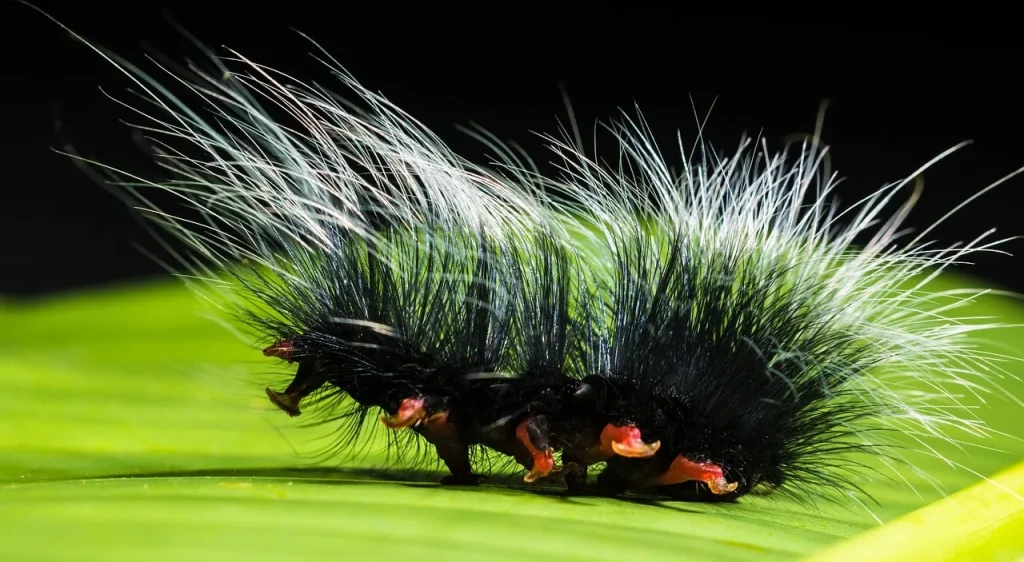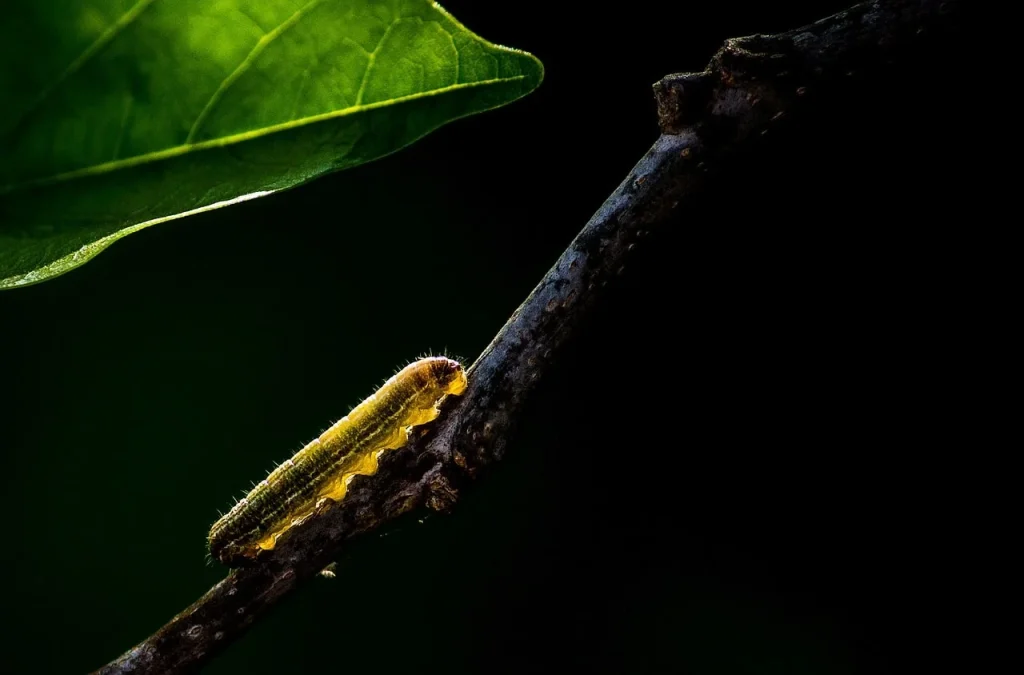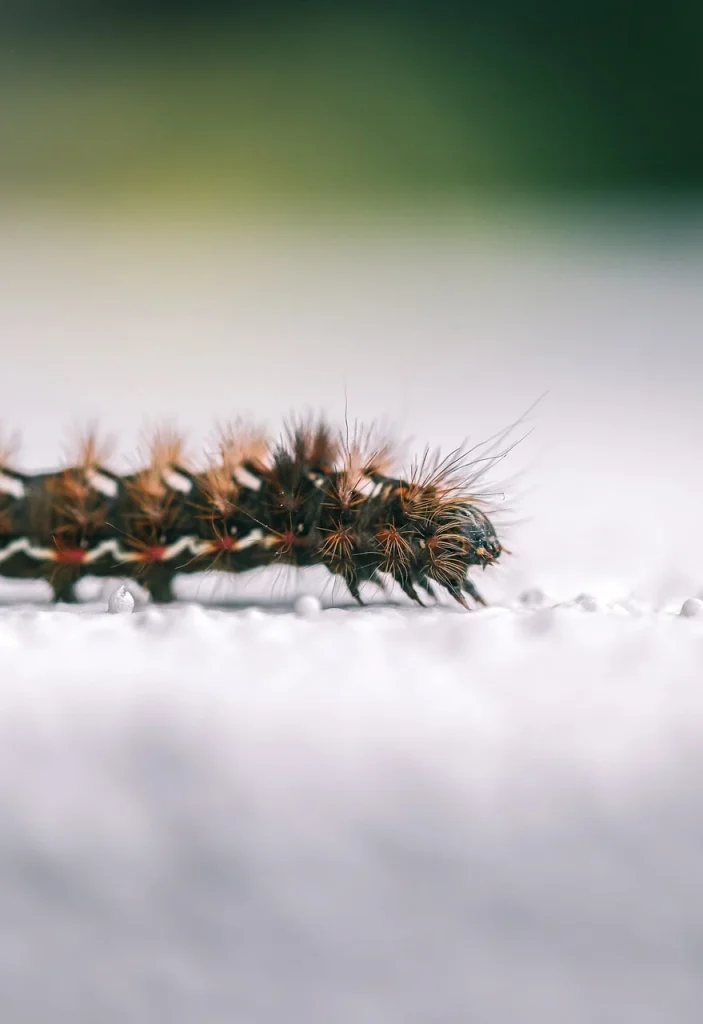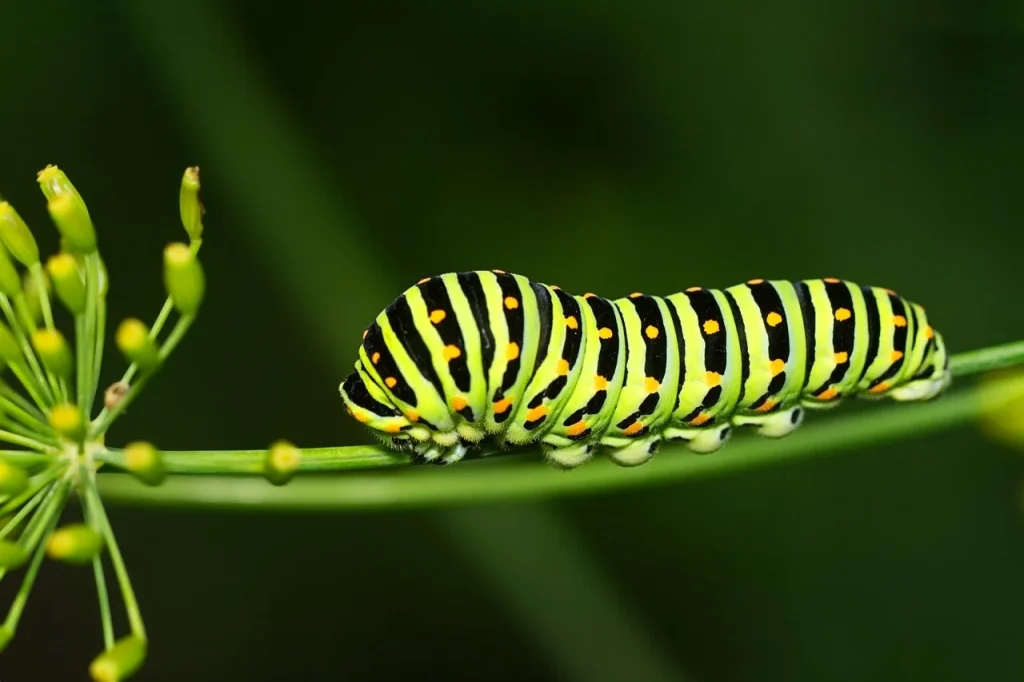Did you know that caterpillars are one of nature’s most interesting architects? Before they morph into stunning butterflies or moths, caterpillars have a lot of growing to do.
This blog will take you through some interesting facts about these little creatures, revealing how they eat, grow, and survive in the wild. Let’s crawl into the world of caterpillars and learn something new today!
And what’s the use of being a butterfly,” thought she, “if you can’t be patient as a caterpillar?
Margaret Atwood
Caterpillar Facts
Let’s start our journey into the world of caterpillars. Read carefully these facts because there is a quiz at the end of this page to test your newfound knowledge.
- Some species can launch their frass (waste) over a meter away to avoid attracting predators.
- They have up to 4,000 muscles in their bodies, compared to humans’ 650.
- Surprisingly, they have up to 12 eyes, called ocelli, though they don’t see well.
- Some can inflate parts of their bodies to mimic snakes, scaring off predators.
- They can digest toxic chemicals from their host plants, becoming poisonous themselves.
- Using silk, they can create shelters, repel attackers, or assist in molting.
- They breathe through spiracles, which are tiny openings along their bodies.
- Some species can survive freezing temperatures by producing antifreeze proteins.
- They have special organs called stemmata, which are simple eyes that detect light intensity.
- Giant silk moths can consume leaves weighing more than 86,000 times their own body weight.
- Some are known to eat ants by mimicking their chemical signals to enter their colonies.
- Many have evolved intricate camouflage patterns to blend into their surroundings perfectly.
- Their primary way of moving is by expanding and contracting their muscles in a wave-like motion.

- Hornworm caterpillars can glow under UV light due to certain fluorescent proteins in their bodies.
- They have sensory hairs, or setae, which help them sense their environment.
- Some produce sounds by rubbing body parts together, a behavior known as stridulation.
- They undergo hypermetamorphosis, where different stages look completely different from each other.
- Specific species can accumulate toxins from milkweed, making them unpalatable to predators.
- They communicate through vibrations, often produced by tapping their mandibles on leaves.
- Their blood is green due to the presence of hemolymph, which lacks red blood cells.
- Many are cannibalistic and will eat each other if food is scarce.
- Some species can sequester alkaloids from plants and release them as a defense mechanism.
- They often have symbiotic relationships with ants, offering sugary secretions in exchange for protection.
- They experience a form of ‘mind control’ by parasitic wasps, which lay eggs inside them.
- Many have false eyespots on their bodies to startle or confuse predators.
- Their exoskeletons provide both support and protection, much like armor.
- They can exhibit different colors and patterns based on temperature and humidity.
- Some species have gregarious behavior, where they feed and travel in groups for protection.

- They often have unique chemical compounds that help deter predators.
- They can regenerate lost body parts, such as legs, during their larval stage.
- Some have been observed practicing cannibalism, particularly in crowded environments.
- They employ various strategies to avoid detection, including mimicry and cryptic coloration.
- They possess a highly developed sense of touch, with numerous tactile hairs.
- Some species can produce clicking sounds to deter predators.
- They have the ability to taste through their feet, aiding in identifying suitable food plants.
- Many secrete defensive chemicals that can cause skin irritation or allergic reactions in humans.
- They can often choose their pupation site based on environmental cues to enhance survival.
- Specialized glands produce silk, which is used for creating cocoons and safety lines.

- They can absorb toxic heavy metals from their environment, which can be used for pollution monitoring.
- Their movement is controlled by ganglia, which are clusters of nerve cells acting as local brains.
- They have an open circulatory system, where their blood freely bathes their organs.
- They can perform an ‘escape jump’ by flicking their bodies if threatened.
- Some species are bioluminescent, emitting light to ward off predators or attract mates.
- Predator-prey interactions have driven the evolution of many unique defense mechanisms in them.
- They often possess mandibles capable of slicing through tough plant material.
- Many species rely on symbiotic bacteria in their guts to help digest plant material.
- They can sometimes be found in unusual places, such as inside fruits, grains, or other stored products.
- They possess the ability to produce sounds by scraping body parts together, a form of communication.
- They have a hydrostatic skeleton, which relies on fluid pressure to maintain body shape and movement.
- Some species can evert glands called osmeteria to release foul-smelling chemicals when threatened.
Caterpillar Myths

Now that we’ve uncovered the facts, let’s dive into the myths surrounding them. It’s time to separate truth from fiction.
- Caterpillars Eat Constantly
While they are known for their hearty appetites, they don’t eat non-stop. They must pause to molt their exoskeletons several times during their larval stage before they can continue feeding and growing. - All Caterpillars Become Butterflies
Not all caterpillars morph into butterflies. Many caterpillars are destined to become moths. The destiny of a caterpillar, whether it turns into a butterfly or a moth, is determined by its species. - Caterpillars are Harmless
Most of them are indeed harmless, but some species can be a nuisance. For instance, the processionary caterpillar has hairs that can cause severe allergic reactions and skin irritations in humans and animals. - Caterpillars Can Eat Anything
They are usually very picky with a specialized diet. Each species typically has specific plants that they feed on, which can sometimes be only one type of leaf, essential for their survival and development. - All Caterpillars Are Solitary
While many caterpillars are solitary, several species are social and live communally. These social caterpillars often work together to build large, protective webs or to forage, demonstrating complex cooperative behaviors.
Caterpillar Quotes

Let’s continue to the quotes section. As always you are welcome to share more in the comments and I will add them to the list.
How does one become a butterfly? You must want to fly so much that you are willing to give up being a caterpillar.
Trina Paulus
Trina Paulus emphasizes the necessity of desire and sacrifice in personal growth and transformation in this motivational quote.
What the caterpillar calls the end of the world, the master calls a butterfly.
Richard Bach
Richard Bach provides a profound perspective on change and rebirth, suggesting that what may seem like an ending is often a new beginning.
Caterpillars can fly, if they just lighten up.
Scott J. Simmerman
Scott J. Simmerman playfully encourages a shift in perspective and attitude to achieve what may seem impossible.
The caterpillar does all the work, but the butterfly gets all the publicity.
George Carlin
With his typical wit, George Carlin points out the disparity between effort and recognition, emphasizing the unnoticed hard work behind visible success.
I am a tiny caterpillar on a leaf, but one day I will wake up as a beautiful butterfly.
Louie Schwartzberg
Louie Schwartzberg captures the essence of hope and potential in this quote, reminding us of the transformative power of nature and time.
Caterpillar FAQ

As we move from the quotes to the FAQ section, remember this is your last stop before the quiz. Read carefully if you want to score a perfect ten.
- Can caterpillars bite?
No, they do not bite. They have a set of strong jaws which are mainly used to chew leaves, not for biting defensively or aggressively. - Why do caterpillars eat leaves?
They eat leaves to gain the necessary nutrients and energy required for growth and development. Since they need to store up energy for their metamorphosis into butterflies or moths, consuming a large amount of leaves is essential. - How do caterpillars turn into butterflies?
They transform into butterflies through a process called metamorphosis. First, they enter the pupa stage by encasing themselves in a chrysalis. Inside, their bodies undergo a remarkable transformation, eventually emerging as butterflies. - Are caterpillars poisonous?
Some caterpillars can be poisonous. They contain toxins which are harmful to predators, serving as a defense mechanism. These toxins can cause irritation or more severe symptoms if touched or ingested, so it’s wise to avoid handling unknown caterpillars. - What is the lifespan of a caterpillar?
The lifespan of a caterpillar varies depending on the species, but most live for about 2 to 4 weeks before transitioning into the pupal stage. Environmental factors and predation also influence their lifespan.
Caterpillar Trivia

Welcome to our caterpillar quiz! Get ready to crawl through some tricky questions, but beware: if you don’t get any right, you might just find yourself turning into a butterfly without any wings!
Conclusion
We’ve reached the end of our exploration into the world of caterpillars. It’s clear these little creatures are not only future flyers but also crucial to our ecological puzzle. By learning about them, we foster a greater respect and enthusiasm for all wildlife.
Keep exploring, and who knows? Maybe you’ll find a caterpillar hard at work right in your backyard! Till next time, stay curious and explore more. Cheers.


